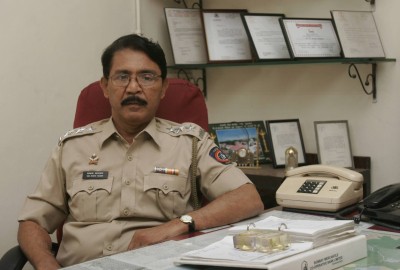
New Delhi, Governments can draw on a whole phalanx of specially-trained, heavily-armed personnel to deal with terror attacks - but in most cases, after the terrorists have struck. The first responder is always the lightly-armed local police, but with inspiring leadership and commitment, it can hold its own till reinforcements arrive. 26/11 was no different and replete with examples of how the Mumbai Police's personnel - at all levels - acted on the ground to contain the marauding LeT terrorists till the armed forces and NSG entered the fray.
"... It was commendable that some policemen had rushed with only lathis (cane/bamboo sticks) to face the terrorists," observed the High-Level Enquiry Committee (HLEC) on 26/11, comprising former Union Home Secretary Ram Pradhan and former IPS officer Vappala Balachandran, formed by the Maharashtra government in December 2008.
Hemant Karkare, Ashok Kamte, Vijay Salaskar, Vishwas Nangare Patil, Sadanand Date, Shashank Shinde, were among those who courageously set out to tackle the situation even as its full scale was not apparent. When the two terrorists who had killed the first three amid their carnage were finally confronted, it was unarmed Assistant Sub Inspector Tukaram Omble who courageously grappled with AK-47-firing Ajmal Kasab, and took the entire gunburst in his chest, preventing him from hitting any one else, and more importantly, ensuring he was captured alive.
Then, there was ACP, Azad Maidan, Isaque Ibrahim Bagwan, who used his meagre resources - a dozen and a half policemen armed with self-loading rifles and a sole tear gas gun - to confront and restrict the terrorists at the Chabad House, and was deterred with great difficulty from storming it with his small force.
Bagwan, who joined the Mumbai Police as an SI in the mid-1970s and is credited with the first recorded 'encounter' killing of Mumbai Police - that of gangster Manya Surve in 1982, almost single-handedly commanded the siege of Chabad House, and while he could not prevent the two terrorists inside from slaughtering the rabbi and his wife, and four others, ensured that other residents of the densely-packed area were safely evacuated and the terrorists pinned down.
As he tells us in his engrossing autobiography "Me Against the Mumbai Underworld" (2018), Bagwan had just reached home at around 9 p.m., when Mumbai Police Commissioner Hasan Ghafoor called him and asked him to go to Cafe Leopold where there were reports of firing. As he reached there with just his driver and wireless operator, he was told of the attack on the Taj Mahal Hotel and decided to proceed there, but changed his plan after an informer told him of a blast on Colaba Road. There, local people told him that terrorists had gone towards Nariman (Chabad) House, and knowing of its significance, rushed there.
Seeing the building in darkness, he requested support from the Control Room and in the meantime, called out local residents - who knew him well due to his prior service - and organised evacuation of over 300 people from all the neighbouring houses without incident. Initially, an SI and three constables armed with SLRs came to his aid, and then nine near-rookies of the State Reserve Police, armed with .303 rifles and one tear gas gun.
"Terrorists have attacked us. They want to destroy our city with their weapons and bombs. But you are all brave men. Do not lose confidence. This city needs you. Fight like warriors of Shivaji Maharaj. Show those terrorists what you are made of," he told his team, as per his account, as well as of then JCP, Crime, (and later Police Commissioner) Rakesh Maria in his "Let Me Say it Now" (2020).
And such was Bagwan's leadership and tactical arrangements that his few men, with their bare functional weapons, kept the terrorists pinned down to the top floors of the building, driving them back every time they came to the ground floor to escape. The communication of the terrorists with their handlers,intercepted by Indian intelligence agencies, indicated their desperation at "being surrounded from all sides" from what they thought was a large force, though it was 20 men at best until the NSG came the next day (November 27), and finally secured the building on November 28 morning.
And Bagwan, who had in the meantime, been stopped from attacking the house from a neighbouring building by placing a door to make a makeshift bridge after Maria, who was manning the Control Room, said they could not afford to lose more men and informed him of the deaths of Karkare, Kamte, and Salaskar, was one of the first inside after the NSG action and was even photographed next to a dead terrorist - still clutching the pin of a live grenade.
The Pradhan Committee, in its observations on Nariman House, said: "Here the situation was handled almost single-handedly by Shri Isaque Ibrahim Bagwan, ACP Azad Maidan division, who deserves high praise in containing the terrorists, keeping them pinned down until the NSG came on the 27th afternoon... The Committee finds that ACP Shri Bagwan had acted with great presence of mind in pinning down terrorists and saving livees almost single-handed."
The action earned Bagwan his third President's Police Medal for Gallantry - a quarter of a century after his first two (in 1984 and 1985), and when it was conferred in 2010, he was granted special permission to don his uniform again (having retired in mid-2009) for the ceremony.


.jpeg)

